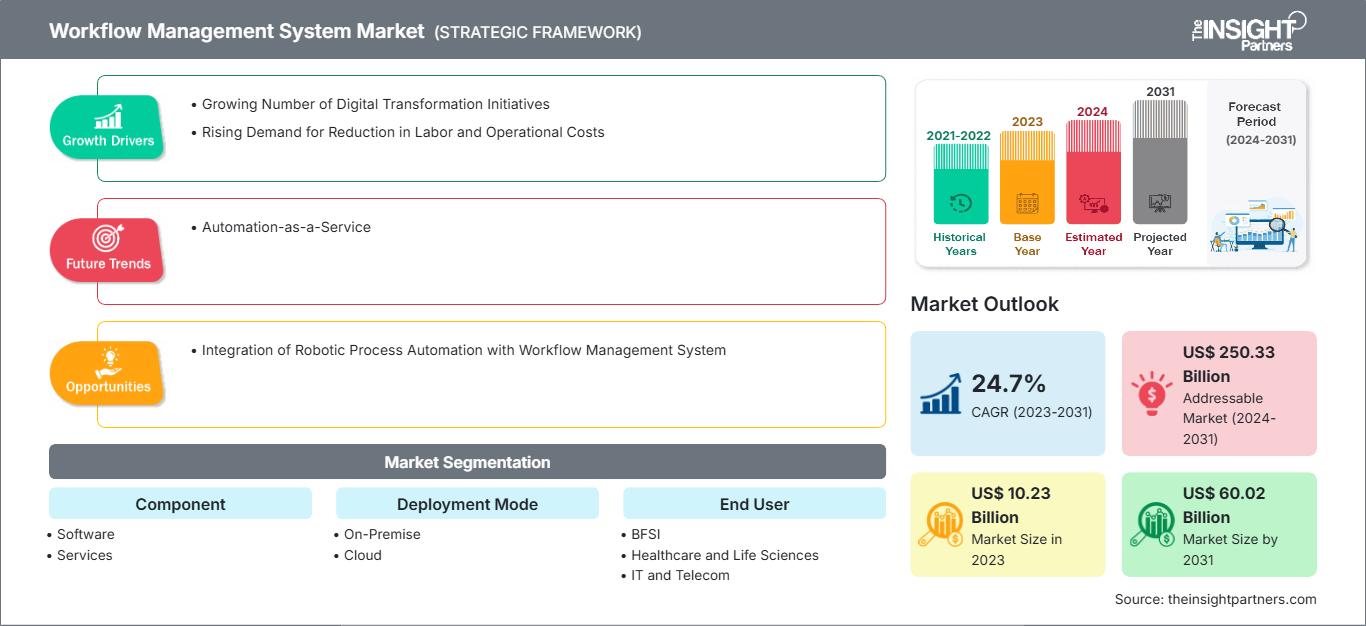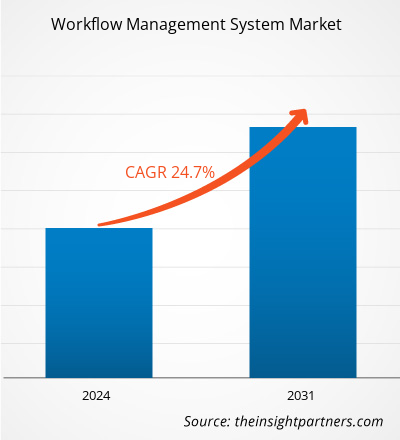ワークフロー管理システムの市場規模は、2023年の102億3,000万米ドルから2031年には600億2,000万米ドルに達すると予測されています。市場は2023年から2031年にかけて24.7%のCAGR(年平均成長率)を記録すると見込まれています。今後数年間、Automation-as-a-Service(自動化サービス)が市場の主要トレンドになると予想されます。
ワークフロー管理システム市場分析
統合されたワークフォースマネジメントソリューションを導入することで、企業全体の誰もが自然なワークフローの一環として関連データにアクセスできるようになります。これにより、疲労や反復作業が軽減されるだけでなく、情報に基づいた意思決定にも役立ちます。分断されたデータセットによる企業全体の問題は、手作業で解決するのは非常に困難です。最新のワークフォースマネジメントシステムを導入することで、企業は従業員と管理者のニーズにリアルタイムで対応することができ、これは人件費と運用コストの削減に不可欠です。さらに、ロボティックプロセスオートメーション(RPA)をワークフロー管理システムに統合することは、現代のビジネス環境においてますます標準的な手法となっています。これにより、より重要なビジネスプロセスの一部として特定のタスクを自動化できるようになり、運用効率と生産性が向上します。
ワークフロー管理システム市場の概要
ワークフロー管理システムは、複数の多様なワークフローツールを統合アプリケーションに統合するプラットフォームとして機能します。このシステムを通じて、ビジネス規制に従って、多数のプロセスを段階的に自動化できます。ワークフローシステムは、機械ベースと人間ベースの両方のタスクを自動化できます。ワークフロー管理とは、ワークフローを効率的に整理し、最適化して最良の結果を達成することです。これには、不要なタスクの排除、すべての活動にリソースが確実に供給されるようにすること、タスクの実行順序を合理化することが含まれます。また、主要なビジネスプロセスワークフローを自動化することで、業務をビジネス目標と整合させ、手動のワークフローシステムに伴う課題を解決できます。ワークフローはビジネスプロセスの基本構成要素であるためです。例えば、調達プロセスは、購買依頼、請求書処理、発注のワークフローで構成されており、それぞれに作成、レビュー、承認、後続プロセスへのルーティングなどのさまざまなタスクが含まれています。
要件に合わせてレポートをカスタマイズ
レポートの一部、国レベルの分析、Excelデータパックなどを含め、スタートアップ&大学向けに特別オファーや割引もご利用いただけます(無償)
ワークフロー管理システム市場: 戦略的洞察

-
このレポートの主要な市場動向を入手してください。この無料サンプルには、市場動向から見積もりや予測に至るまでのデータ分析が含まれます。
ワークフロー管理システム市場の推進要因と機会
人件費と運用コストの削減に対する需要の高まり
統合されたワークフォースマネジメントソリューションを導入することで、企業全体の誰もが自然なワークフローの中で関連データにアクセスできるようになります。これは、疲労や反復作業を軽減するだけでなく、情報に基づいた意思決定にも役立ちます。分断されたデータセットによる企業全体の問題を手動で解決するのは非常に困難です。最新のワークフォースマネジメントシステムを導入することで、企業は従業員と管理者のニーズにリアルタイムで対応することができ、これは人件費と運用コストの削減に不可欠です。自動化は人件費削減において重要な役割を果たします。自動化ワークフロー、プロジェクト管理ソフトウェア、AI搭載システムなどのツールは、ワークフローの自動化を導入するのに役立ち、労働集約的なタスクの完了時間を短縮し、コスト削減を促進します。自動化は、製造業などの業界における人件費削減に特に効果的です。自動化されたワークフローにより、システムがタスクを効率的に処理できるようになり、従業員は組織内のより重要なタスクに集中できるようになります。例えば、アーンスト・アンド・ヤングは人件費の削減とワークフロー管理の改善に成功しました。同社は人事業務に関連する総コストを推定する調査を実施し、これらの業務に関連する総コストの大部分を人件費が占めていることを発見しました。完全に自動化されたワークフロー管理ソリューションを実装することで、効率性を高め、運用経費を削減することができ、経営陣と人事部門は戦略的な活動に集中できるようになりました。このように、人件費と運用費の削減に対する需要の高まりが、ワークフロー管理システム市場の成長を促進しています。
ロボティック・プロセス・オートメーションとワークフロー管理システムの統合
ロボティック・プロセス・オートメーション(RPA)をワークフロー管理システムに統合することは、現代のビジネス環境においてますます標準的な慣行になりつつあります。これにより、特定のタスクをより重要なビジネスプロセスの一部として自動化できるようになり、運用効率と生産性が向上します。例えば、2023年には、Gmailベースのコミュニケーションとコラボレーションに特化したプラットフォームであるGmeliusが、ワークフロー管理システム内でRPAを巧みに採用し、業務運営を合理化しました。 Forbesの特集記事では、Gmeliusが包括的なデジタルワークフロー自動化の実現において人工知能(AI)が極めて重要な役割を担っていることを認識し、特にRPAを自動化の主要なユースケースとして強調していることが取り上げられています。Gmeliusは、自動化を統合プラットフォームに統合することに成功し、一般的なワークフローの課題に効果的に対処し、ワークフロープロセスを迅速化するソリューションを提供しています。この統合は、ワークフロー管理システム内でRPAを効果的に適用することで、タスク実行を改善し、業務全体の強化を図る好例であり、より広範なビジネスプロセス内の特定のタスクを自動化し、効率性と拡張性を向上させるRPAの可能性を示しています。したがって、ロボティックプロセスオートメーションとワークフロー管理システムの統合は、予測期間中に市場成長の大きな機会を生み出すと期待されています。
ワークフロー管理システム市場レポートのセグメンテーション分析
ワークフロー管理システム市場分析の導出に貢献した主要セグメントは、コンポーネント、導入モード、エンドユーザーです。
- コンポーネントに基づいて、市場はソフトウェアとサービスに分割されています。ソフトウェアセグメントは、スイートベースのワークフローシステム、Webベースのワークフローシステム、プロダクションワークフローシステム、およびメッセージングベースのワークフローシステムに細分化されています。サービスセグメントは、統合と実装、コンサルティング、トレーニングと開発にさらに細分化されています。ソフトウェアセグメントは、2023年に大きな市場シェアを占めました。
- 展開モードの点では、市場はオンプレミスとクラウドに分かれています。クラウドセグメントは、2023年に大きな市場シェアを占めました。
- エンドユーザー別に、市場はBFSI、ITおよび通信、ヘルスケアおよびライフサイエンス、小売、輸送および物流、食品および飲料、化粧品業界、その他に分割されています。BFSIセグメントは、2023年に最大の市場シェアを占めました。
地域別のワークフロー管理システム市場シェア分析
ワークフロー管理システム市場レポートの地理的範囲は、主に北米、アジア太平洋、ヨーロッパ、中東およびアフリカ、南アフリカの5つの地域に分かれています。中央アメリカ。
アジア太平洋地域は2023年に大きな市場シェアを占めました。アジア太平洋諸国のダイナミックな医療環境において、革新的な医療ワークフロー管理システムへの需要が急増し、Appianのような企業の台頭につながりました。Appianが開発した最先端のワークフロー管理システムは、この地域の医療提供者特有の要件に合わせて特別にカスタマイズされています。そのプラットフォームは、既存の医療ITインフラとのシームレスな統合を提供し、臨床ワークフローの合理化、管理タスクの自動化、そして規制基準の遵守を確保します。データ分析と人工知能を活用することで、Appianは医療機関の業務効率と患者ケアの提供を向上させ、アジア太平洋地域の進化するトレンドへの適応をさらに支援します。IT・通信分野におけるワークフロー管理ソフトウェアとサービスの導入は、業務の合理化と効率的なタスク管理の確保に不可欠です。例えば、通信業務において、ワークフロー管理システムは、スペクトル管理やインフラ投資といった、この地域の主要国の多様な規制環境の影響を受けるタスクをシームレスに調整することを可能にします。
ワークフロー管理システム市場
ワークフロー管理システム市場に影響を与える地域的なトレンドと要因は、The Insight Partnersのアナリストによって予測期間を通じて詳細に説明されています。このセクションでは、ワークフロー管理システム市場のセグメントと地域についても、北米、ヨーロッパ、アジア太平洋、中東・アフリカ、中南米に分けて解説しています。
ワークフロー管理システム市場レポートの範囲
| レポート属性 | 詳細 |
|---|---|
| の市場規模 2023 | US$ 10.23 Billion |
| 市場規模別 2031 | US$ 60.02 Billion |
| 世界的なCAGR (2023 - 2031) | 24.7% |
| 過去データ | 2021-2022 |
| 予測期間 | 2024-2031 |
| 対象セグメント |
By コンポーネント
|
| 対象地域と国 |
北米
|
| 市場リーダーと主要企業の概要 |
|
ワークフロー管理システム市場のプレーヤー密度:ビジネスダイナミクスへの影響を理解する
ワークフロー管理システム市場は、消費者の嗜好の変化、技術の進歩、製品メリットへの認知度の高まりといった要因によるエンドユーザーの需要増加に牽引され、急速に成長しています。需要が高まるにつれ、企業は提供内容を拡大し、消費者ニーズを満たすための革新を進め、新たなトレンドを捉えることで、市場の成長をさらに加速させています。

- 入手 ワークフロー管理システム市場 主要プレーヤーの概要
ワークフロー管理システム市場のニュースと最新動向
ワークフロー管理システム市場は、一次調査および二次調査後の定性データと定量データを収集することで評価されます。これには、重要な企業出版物、協会データ、データベースが含まれます。ワークフロー管理システム市場におけるいくつかの動向を以下に示します。
- Veeva Systems(NYSE:VEEV)は、GMPリリースおよび市場出荷の決定をより迅速かつ確実に行うことができる新しいクラウドアプリケーション、Veeva Vault Batch Releaseを発表しました。Vault Batch Releaseは、データとコンテンツの集約とレビューを合理化し、外部パートナーとのコラボレーションを簡素化することで、製造およびサプライチェーンの複雑性の増大に対処します。(出典:Veeva Systems、プレスリリース、2023年9月)
- ライフサイエンス分野向けeQMSコンプライアンスソリューションの大手プロバイダーであるDot Complianceは、組み込みの生成型および予測型人工知能を搭載した、業界初のすぐに使用できるAIベースのライフサイエンス向け電子品質管理システムを発表しました。このシステムは、独自のアルゴリズムと組み合わせた ChatGPT を導入して、品質プロセスを最適化し、タスクを自動化し、品質保証に携わる専門家が組織のコンプライアンス強化に集中できるようにします。 (出典:Dot Compliance Ltd.、プレスリリース、2023年4月)
ワークフロー管理システム市場レポートの対象範囲と成果物
「ワークフロー管理システム市場規模と予測(2021~2031年)」レポートは、以下の分野を網羅した詳細な市場分析を提供します。
- 対象範囲に含まれるすべての主要市場セグメントにおける、世界、地域、国レベルでのワークフロー管理システム市場規模と予測
- ワークフロー管理システム市場の動向、および推進要因、制約要因、主要な機会などの市場動向
- 詳細なPEST分析とSWOT分析
- 主要な市場動向、世界および地域の枠組み、主要プレーヤー、規制、および最近の市場動向を網羅したワークフロー管理システム市場分析
- 市場集中、ヒートマップ分析、主要プレーヤー、およびワークフロー管理システム市場の最近の動向を網羅した業界展望と競合分析
- 詳細な企業プロファイル
- 過去2年間の分析、基準年、CAGRによる予測(7年間)
- PEST分析とSWOT分析
- 市場規模価値/数量 - 世界、地域、国
- 業界と競争環境
- Excel データセット
最新レポート
関連レポート
お客様の声
購入理由
- 情報に基づいた意思決定
- 市場動向の理解
- 競合分析
- 顧客インサイト
- 市場予測
- リスク軽減
- 戦略計画
- 投資の正当性
- 新興市場の特定
- マーケティング戦略の強化
- 業務効率の向上
- 規制動向への対応






















 無料サンプルを入手 - ワークフロー管理システム市場
無料サンプルを入手 - ワークフロー管理システム市場